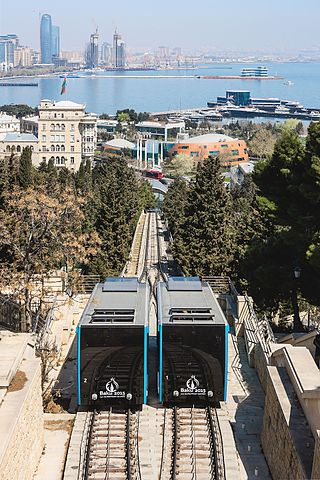
A funicular is a type of cable railway system that connects points along a railway track laid on a steep slope. The system is characterized by two counterbalanced carriages permanently attached to opposite ends of a haulage cable, which is looped over a pulley at the upper end of the track. The result of such a configuration is that the two carriages move synchronously: as one ascends, the other descends at an equal speed. This feature distinguishes funiculars from inclined elevators, which have a single car that is hauled uphill.

Fribourg is the capital of the Swiss canton of Fribourg and district of La Sarine. Located on both sides of the river Saane/Sarine, on the Swiss Plateau, it is a major economic, administrative and educational centre on the cultural border between German-speaking and French-speaking Switzerland. Its Old City, one of the best-maintained in Switzerland, sits on a small rocky hill above the valley of the Sarine. In 2018, it had a population of 38,365.

The Harderbahn (HB) is one of two funiculars that operate from the town of Interlaken. The Harderbahn leads to the western end of the Harder in the north of Interlaken across the river Aare, in Switzerland.

The Territet–Glion funicular railway is a funicular in Switzerland, which runs between the Territet and Glion suburbs of the town of Montreux. At its upper terminus, the funicular connects with the Montreux–Glion–Rochers-de-Naye railway line.

The Montmartre Funicular is an inclined transport system serving the Montmartre neighbourhood of Paris, France, in the 18th arrondissement. Operated by the RATP, the Paris transport authority, the system opened in 1900; it was entirely rebuilt in 1935 and again in 1991.

The Funiculaire de Saint-Hilaire du Touvet, or Saint-Hilaire du Touvet Funicular, is a funicular railway in the département of Isère in the Rhône-Alpes region of France. It links Montfort on the road between Grenoble and Chambéry, with the village of Saint-Hilaire du Touvet, located on the Plateau des Petites Roches 600 metres (1,969 ft) above.

The Lac d'Émosson is a reservoir in the canton of Valais, Switzerland. It is located in the municipalities of Salvan and Finhaut. The closest small city in Switzerland is Martigny. The lake has a surface area of 3.27 km2 and an elevation of 1,930 m. The maximum depth is 180 meters. The purpose of the Émosson Dam is hydroelectric power generation. Water from the reservoir first powers the 189 MW Vallorcine Power Station downstream and just over the border in Vallorcine, France. Water is then sent through a headrace tunnel to the 190 MW La Bâtiaz Power Station, 12 km (7 mi) to the east in Martigny, Switzerland. The drop between the dam and La Bâtiaz Power Station is 1,400 m (4,593 ft).

The Old Quebec Funicular is an inclined elevator, formerly a funicular railway, in the Old Quebec neighbourhood of Quebec City, Quebec, Canada. It links the Haute-Ville at Dufferin Terrace to the Basse-Ville at Rue du Petit-Champlain. The Basse-Ville includes such sites as the colonial-era Notre Dame des Victoires church, the historic Petit Champlain district, the port, and the Musée de la civilisation. Climbing at a 45-degree angle, the railway covers a total distance of 64 metres (210 ft).

The Les Avants–Sonloup funicular is a metre gauge funicular railway in the Swiss canton of Vaud. It links the railway station of Les Avants, on the Montreux–Lenk im Simmental line between Montreux and Montbovon, with an upper terminus at Sonloup.

The Parsenn Funicular is a funicular railway in the resort of Davos in the Swiss canton of Graubünden. The line links the town of Davos with the Weissfluhjoch ridge and the Parsenn ski area.

The Swiss Bishops' Conference is the coordinating body of the Catholic dioceses in Switzerland. It was founded in 1863 as the world's first Bishops Conference and is a member of the Council of European Bishops' Conferences.

The St. Moritz–Corviglia Funicular is a funicular railway in the canton of Graubünden, Switzerland. The line links the town of St. Moritz at 1848 m with the Corviglia summit and ski area at 2489 m, and comprises two sections of differing gauge, with passengers changing cars at the intermediate station of Chantarella.
The Libero-Tarifverbund is a Swiss tariff network covering the canton of Bern and the southwestern part of the canton of Solothurn. It was established in December 2004 from the merger of the Bäre-Abi and Frosch-Abo tariff networks. The Zig-Zag network merged into Libero in 2014. With the merger of the Tarifverbund Berner Oberland ("BeoAbo"), covering the Bernese Oberland, in December 2019, the network covers the entire canton of Bern.

Funiculaire Moléson-sur-Gruyères – Plan-Francey is a funicular railway in the Canton of Fribourg, Switzerland. The line leads from Moléson-sur-Gruyères at 1111 m to Plan-Francey at 1520 m. From there, an aerial cableway continues to the summit of Moléson. The line of the funicular has a length of about 1350 m and a difference of elevation of 409 m. The funicular with two cars has a single track with a passing loop.

Funiculaire de St-Luc - Tignousa is a funicular railway in the Anniviers valley, Valais, Switzerland. The line leads from St-Luc at 1680 m to Tignousa at 2180 m. It provides access to the skiing area St-Luc-Chandolin and also operates in summer season. The line has a length of 1300 m and a difference of elevation of 500 m.
A Water balancea railway is a funicular, aerial tramway or cable railway that uses the weight of water to move its carriages.














